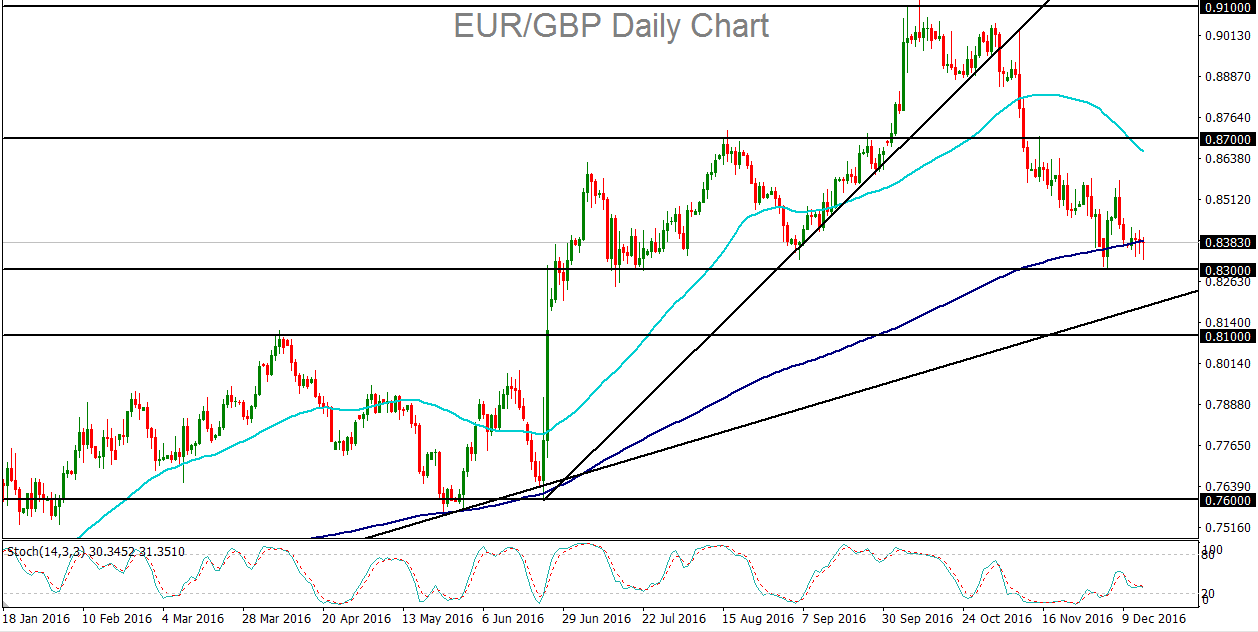EUR/GBP has been falling sharply since early November as the pound has gained back some traction after hitting Brexit-driven, multi-decade lows against the US dollar in October. At the same time, the euro has been weighed down by continuing economic worries in Europe and a consistently dovish European Central Bank (ECB).
Both the ECB and Bank of England (BoE) have issued their latest policy decisions, and not much has changed as a result. The ECB continued to lean rather unmistakably towards the dovish side last week as it extended its quantitative easing program for a longer-than-expected nine months – to December of 2017. Although the central bank also confirmed that it would begin tapering its bond purchases starting in April, it was careful not to characterize this as a tapering-to-zero. Meanwhile, the BoE, which just issued its decision on Thursday, continues to maintain a neutral policy stance. As expected, no interest rate changes were made, and the central bank remains torn between expectations of higher inflation pressures and the specter of a looming Brexit process. Governor Mark Carney said on Thursday that the Bank of England can now respond “in either direction.”
Therefore, on the dovish-to-hawkish central bank spectrum, the ECB staunchly remains the most dovish while the Fed is clearly the most hawkish, and the BoE falls somewhere in-between. What does this likely mean for these central banks’ respective currencies? We’ve already clearly seen the sharply positive effect of Wednesday’s hawkish Fed outlook on the US dollar. Likewise, last week’s dovish QE extension by the ECB led to a euro sell-off. As for the pound, the BoE’s neutral stance is less of a currency-mover than other central banks’ stances. Against the euro, however, the pound is likely to continue holding the edge due to the modest but significant monetary policy divergence between the ECB and BoE.
From a price action perspective, as noted, EUR/GBP has been falling sharply since early November, after the currency pair broke down below a steep uptrend line that has been in place since June’s UK Referendum. After breaking down below that trend line, EUR/GBP followed-through further to break down below the key 0.8700 support level. Most recently, price sharply extended its slide then bounced from the major 0.8300 support area last week. Currently, the currency pair has once again dropped to approach this important level. With any continuation of the downside momentum for the euro and rebound for the heavily oversold pound, a breakdown below the 0.8300 support level could open the way in the near-term towards downside targets at 0.8100 support and the 0.8000 psychological level.
Both the ECB and Bank of England (BoE) have issued their latest policy decisions, and not much has changed as a result. The ECB continued to lean rather unmistakably towards the dovish side last week as it extended its quantitative easing program for a longer-than-expected nine months – to December of 2017. Although the central bank also confirmed that it would begin tapering its bond purchases starting in April, it was careful not to characterize this as a tapering-to-zero. Meanwhile, the BoE, which just issued its decision on Thursday, continues to maintain a neutral policy stance. As expected, no interest rate changes were made, and the central bank remains torn between expectations of higher inflation pressures and the specter of a looming Brexit process. Governor Mark Carney said on Thursday that the Bank of England can now respond “in either direction.”
Therefore, on the dovish-to-hawkish central bank spectrum, the ECB staunchly remains the most dovish while the Fed is clearly the most hawkish, and the BoE falls somewhere in-between. What does this likely mean for these central banks’ respective currencies? We’ve already clearly seen the sharply positive effect of Wednesday’s hawkish Fed outlook on the US dollar. Likewise, last week’s dovish QE extension by the ECB led to a euro sell-off. As for the pound, the BoE’s neutral stance is less of a currency-mover than other central banks’ stances. Against the euro, however, the pound is likely to continue holding the edge due to the modest but significant monetary policy divergence between the ECB and BoE.
From a price action perspective, as noted, EUR/GBP has been falling sharply since early November, after the currency pair broke down below a steep uptrend line that has been in place since June’s UK Referendum. After breaking down below that trend line, EUR/GBP followed-through further to break down below the key 0.8700 support level. Most recently, price sharply extended its slide then bounced from the major 0.8300 support area last week. Currently, the currency pair has once again dropped to approach this important level. With any continuation of the downside momentum for the euro and rebound for the heavily oversold pound, a breakdown below the 0.8300 support level could open the way in the near-term towards downside targets at 0.8100 support and the 0.8000 psychological level.

Latest market news
Today 09:11 AM
Yesterday 11:57 PM
Yesterday 08:25 PM
Yesterday 07:48 PM


